
How I made travel website a second Wikipedia [Case Study]

Hello. My name’s Stanislav Peev, and I’m here to share how I made my client’s website rank second after Wikipedia with the help of a new content strategy in just two months.
About the project
My client is Exotic Holiday — one of the biggest tour operators in Bulgaria, specializing in tours to exotic destinations, as well as organizing more traditional tours such as event tourism, cruises, business and educational trips, etc.
The company was pretty well-known in Bulgaria, but, unfortunately, far less known in SERP because of poorly organized content. It was thin and actually scrapped from other websites of the niche. What’s more, this content was used on dozens or even hundreds of other websites, as the tour programs were pretty similar, and their descriptions were copied many times, too.
The SEO strategy I followed
As the product my client was selling was not unique, it was way too difficult to create unique, non-repetitive descriptions to beat the high-ranking niche competitors. Of course, I did try rewriting the descriptions to make them a little different, but it didn’t help the website get any positions at all.
So I decided to rebuild the content strategy from scratch and create unique, descriptive content for each country my client was working with. So I started creating multiple homepages with helpful information about each country and its famous tourist sites separated in multiple tabs:

- The first tab — Information — loads by default
- The second tab is Transport
- The third tab is Bars/Restaurants
- The fourth tab is Shopping
- The fifth tab is Attractions
- The sixth tab is FAQ
Using Rank Tracker to find new keywords
I used Rank Tracker to create the content for each section of new homepages. Luckily, Rank Tracker supports the Bulgarian language, so I had no trouble finding all the keywords and related searches for Узбекистан (Uzbekistan) and all the other countries present on my client’s website.
Actually, what I did was only enter the seed keyword — the software did the rest. Most of the keywords I later used in the new content I found via the Autocomplete Tools and Related Searches modules.

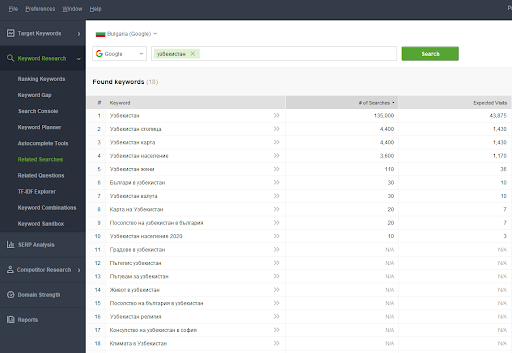
Using LinkAssistant to grow backlinks
In addition to Rank Tracker, I used one more SEO PowerSuite tool, LinkAssistant, to grow the website’s backlinks thus increasing organic traffic and the website’s credibility.
I found websites where I could get some links to my client’s pages through comments, however I did not link to the page itself in general but to the pieces of useful information to pass moderation.
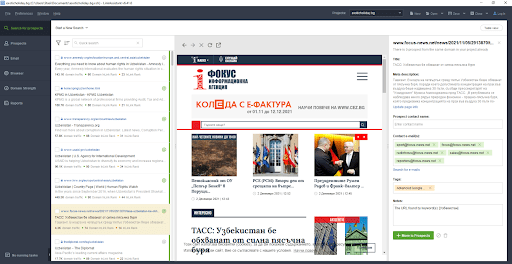
I did the procedure for all the countries’ landing pages of my client’s website — and it’s 102 countries with more than 2500 tourist sites.
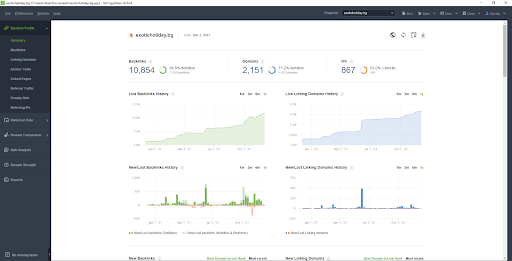
Identifying search intent of the newly-found keywords
To make sure all the keywords I’ve collected can be used on a single page, I needed to check their search intent.
Keywords often contain not only the subject of the search itself (say, ginger cookies) but also intent modifiers — additional words that mark the purpose of the search (i.e. ginger cookies buy).
Each intent has certain markers that signalize the actual reason why a user is searching for something. Thus, the query cake buy means that a user wants to buy a cake, and cake recipe signalizes a user’s need to learn how to cook a cake on their own.
Conversion pages will most often be triggered with the queries that include transactional intent markers, which clearly express the user’s intention to perform a specific target action, for example:
- keyword + buy/order — conversion pages with the ability to make a purchase or place an order
- keyword + price — product pages with prices
- keyword + download — pages where you can download anything
Pages with a commercial investigation intent most often appear in SERPs for the queries with investigational intent, when a user is willing to learn more about a product:
- keyword + reviews — review pages
- keyword + compare — a page where several products are reviewed and compared
If a page is meant to deliver any kind of information, then it’s likely to be found with search queries that include informational intent markers, such as:
- keyword + guide/tutorial — pages with guides on how to do something
- how to… + keyword — pages that provide any kind of instructions
According to my research, almost 80% of the search queries I picked for the new page have information intent. Due to this fact, I could use all of my new keywords on a single page.
Google NLP and AI analysis
Once I created and refined the content, I decided to check if Google understands all the entities in it the way I actually meant. For example, I took the following sentence:
Since the beginning of the year, more than 10 000 Bulgarian tourists have visited Zanzibar Island with just one of the charter companies.
And tested it with the Google Natural Language API. It’s a tool that helps you see how Google understands your page thus find out how relevant a page is to the initial intent you created it for. And here’s what I’ve got.
In terms of entities, Google figured out the following:
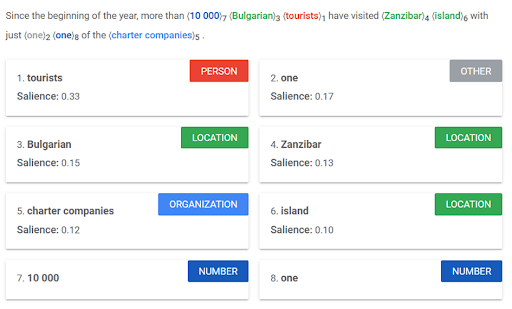
As you can see, Google managed to understand my clients’ s category right — it’s Travel/Tourist Destinations.
Let’s move further and see the Document and Sentence Level Sentiment according to Google.
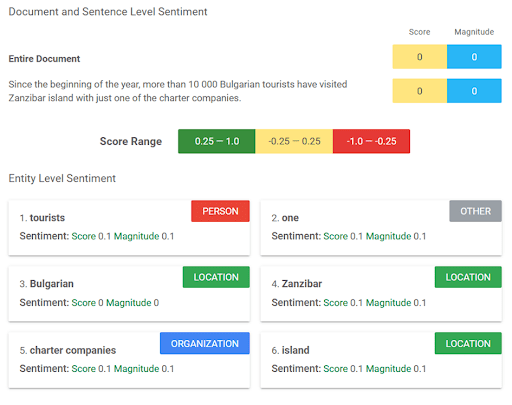
Finally, let’s move to Google’s understanding of the syntax.
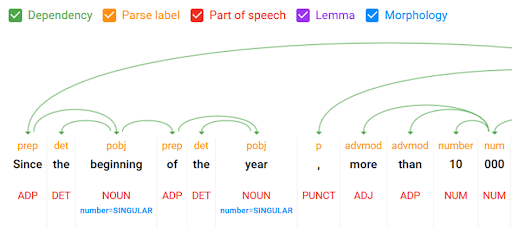
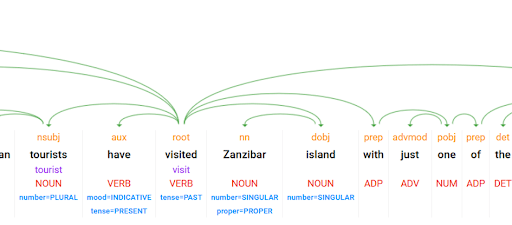
As you can see from the example above, Google managed to understand the content correctly and figured out how the entities in the sentence are related to one another. This made me sure that Google will properly understand and classify all the rest of the content I created for my client’s website.
There is another tool that helped me check the context behind my texts — Pixel Tool. Here’s the example of how this tool analyzed the query почивка занзибар (Zanzibar holiday) and the intent behind it.

The second-to-last line shows the entities the tool considers topically related to the given query. In this case, these entities are: island, overnight stay, flight, excursion, Tanzania. Well, this actually makes sense. All these keywords are related to Zanzibar Holiday, so I decided to use them in my content, too.
The SEO campaign results
All the above-listed efforts made my client’s website a kind of mini-Wikipedia, with the well-structured, entity-rich and well-linked content. And the success in SERP was soon to come — with top positions in most of the Bulgarian SERPs, exoticholiday.bg ranks second after the original Wikipedia in two months after implementing the new content strategy and growing backlinks.
Lets’s look at the SERP for the query “узбекистан” (Uzbekistan):
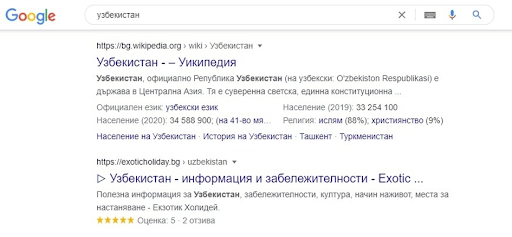
Once you visit my client’s page, you’ll find that the structure is actually similar to that of Wikipedia — you can watch some videos, read some general information, geolocation stats, demographic and cultural peculiarities, and, of course, know more about touristic sites, cafes and restaurants, shopping facilities, etc.
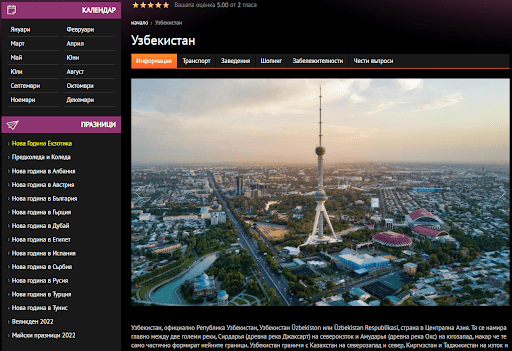
The Sightseeing section includes 20 of the most popular touristic sites in Uzbekistan, further increasing the coverage.
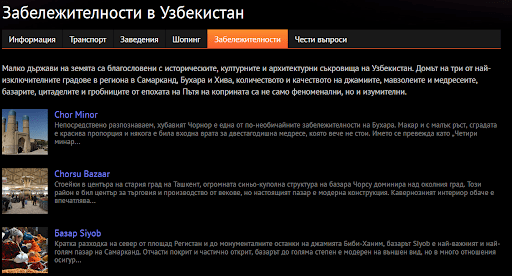
As you can guess, the above-mentioned improvements were performed not only for Uzbekistan but for all the other countries’ pages of the website.
Did you have experience with similar niche projects? Or maybe you'd like to ask Stanislav any questions related to his SEO campaign? Feel free to share your opinion and questions in the comments below.
Author bio: Stanislav has been doing SEO for nine years. His main goals are to apply the best tools and practices to achieve great results for clients. Stanislav strives to stay up to date with the latest SEO trends, so he takes part in many international SEO events and training courses. He has been using SEO PowerSuite since 2015. In his spare time, he likes to travel and learn about the cultures of different nations.




